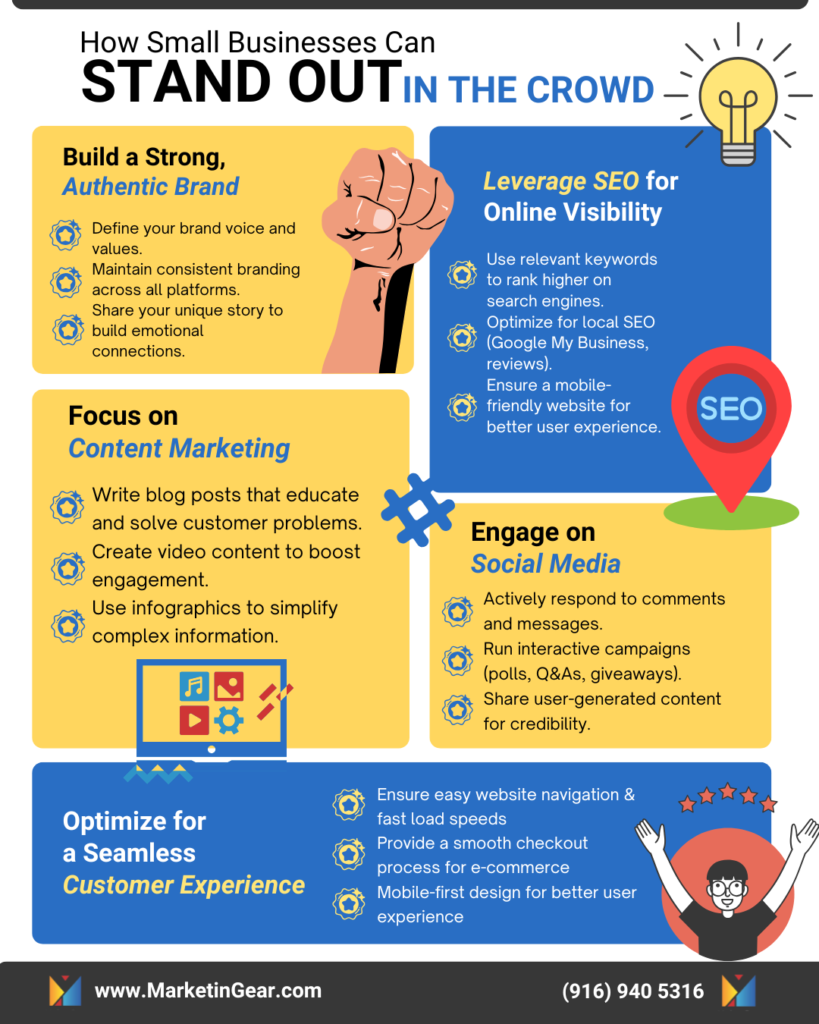Introduction
The digital landscape is more competitive than ever. With millions of small businesses vying for attention, it’s easy to get lost in the noise. But here’s the good news: standing out online isn’t just possible—it’s achievable, even for small businesses.
In 2025, competition is fierce. Consumers have more choices than ever, and they’re becoming more discerning about where they spend their time and money. So, how do you make your business visible and compelling enough to grab attention in this vast digital sea?
In this article, we’ll explore practical and actionable SMB branding tips that will help you stand out in a crowded digital market and build a unique online presence.

Why Small Businesses Need to Stand Out Online
1. The Growing Competition
The internet has created unprecedented opportunities for small businesses to compete on a level playing field with larger corporations. However, this increased accessibility also means heightened competition, making it more challenging to capture and retain customer attention. With millions of businesses vying for online visibility, consumers are overwhelmed with choices. To truly stand out, you need more than just a well designed website you need a robust digital marketing strategy that not only attracts visitors but also fosters brand loyalty and keeps your business top of mind.
2. Changing Consumer Behavior
Consumer behavior has drastically evolved in recent years, driven by advancements in technology and changes in how people interact with brands. Traditional advertising and word-of-mouth recommendations are no longer the sole influencers of purchasing decisions. Instead, consumers actively research products and services online, compare options, and seek out social proof through online reviews, testimonials, and social media engagement before making a decision. With the rise of influencer marketing, personalized recommendations, and AI-driven content, consumers expect brands to be highly responsive, informative, and engaging. This makes standing out online a non-negotiable element of any successful business strategy, requiring businesses to build trust, provide value, and foster authentic connections with their audience.
So, how can you improve your online visibility and get noticed by the right people? The key lies in identifying and leveraging your brand’s unique strengths while utilizing a strategic mix of digital marketing tactics. This includes crafting a compelling brand narrative, optimizing for search engines, engaging with your audience on social media, and consistently delivering valuable content. By doing so, you can establish a strong digital presence that not only attracts attention but also fosters long-term customer loyalty.
Key Strategies to Stand Out in the Crowded Digital Market
1. Build a Strong, Authentic Brand Identity
Before you can stand out, your business needs to establish a distinct and compelling identity that truly resonates with your target audience. Authenticity is not just a buzzword—it’s a crucial factor in differentiating your brand in a market saturated with similar offerings. A well-defined identity goes beyond just a logo or a tagline; it encompasses your brand’s mission, values, and the unique value proposition you bring to your customers. To successfully carve out your space in the digital market:
- Define your brand voice: Your brand voice sets the tone for how customers perceive and interact with your business. Is your business fun and playful, exuding energy and creativity? Or is it professional and reliable, instilling trust and authority? Your brand voice should align with your company’s core values, mission, and audience preferences. It should be consistent across all communication channels, from website copy to social media interactions, ensuring that your brand remains recognizable and relatable to your target customers.
- Consistency is critical: Branding consistency is the foundation of a strong and recognizable business identity. Use uniform branding elements across all digital platforms, including your website, social media, email marketing, and advertisements. This means maintaining a cohesive color scheme, logo placement, typography, and tone of voice that align with your brand’s values. Consistency not only builds credibility and trust with your audience but also reinforces brand recall, making it easier for potential customers to recognize and connect with your business wherever they encounter it online.
- Tell your story: People love a compelling narrative—it helps humanize your brand and creates an emotional connection with your audience. Share why your business was founded: Was it inspired by a personal experience, a market gap, or a passion for solving a problem? Highlight the driving force behind your brand’s mission and values. Explain how your products or services improve your customers’ lives, providing real-life examples or testimonials that illustrate your impact. A well-crafted story differentiates your business, making it memorable and relatable in a crowded digital space.
A strong brand identity helps customers connect with you on a deeper level, making them more likely to choose you over competitors.
2. Leverage SEO to Improve Online Visibility
Search Engine Optimization (SEO) remains one of the most powerful tools for increasing online visibility and driving organic traffic to your business. Small businesses can leverage a combination of on-page and off-page SEO techniques to improve their search engine rankings and reach their target audience more effectively. By optimizing website content, enhancing site structure, and building high-quality backlinks, businesses can increase their chances of appearing at the top of search results and attracting potential customers who are actively searching for their products or services.
Key SEO tips:
- Keyword Optimization: Conduct thorough keyword research using tools like Google Keyword Planner, Ahrefs, or SEMrush to identify high-traffic, relevant keywords for your industry. Focus on a mix of short-tail and long-tail keywords to capture a broader audience. These keywords should be strategically and naturally incorporated into your website’s content, blog posts, meta descriptions, headers, and even image alt text to enhance search engine rankings. Additionally, consider using semantic keywords and related search terms to improve contextual relevance and attract more organic traffic.
- Local SEO: Optimizing for local search is essential for small businesses looking to attract nearby customers. Start by ensuring your Google My Business (GMB) listing is up to date with accurate business details, including your address, phone number, website, and business hours. Enhance your profile by adding high-quality photos, a compelling business description, and relevant categories. Encourage satisfied customers to leave reviews, as positive ratings can improve your local search rankings and build trust with potential clients. Additionally, optimize your website for local SEO by incorporating location-specific keywords, creating localized content, and ensuring your business is listed on relevant online directories such as Yelp, Bing Places, and Apple Maps. Leveraging local SEO strategies will increase your visibility in geo-targeted searches and help drive foot traffic to your business.
- Mobile Optimization: With more users browsing the web on mobile devices, mobile optimization is no longer optional. Ensure your website is responsive and provides a seamless user experience on mobile devices. A mobile-friendly design includes fast load speeds, easy-to-read text, and intuitive navigation. Additionally, consider implementing Accelerated Mobile Pages (AMP) to enhance mobile performance and improve search rankings. A well-optimized mobile site not only improves user experience but also boosts conversions and engagement.
By investing time and effort into SEO, you’ll make it easier for potential customers to find you when they’re searching for products or services you offer.
3. Focus on Content Marketing
Content marketing is one of the best ways to demonstrate your expertise and build trust with your audience. By consistently producing high-quality, valuable content, you can position your business as an authority in your industry and stand out in a crowded digital market.
Content marketing strategies include:
- Blogging: Write helpful, informative articles that answer common questions or solve problems for your audience. Regularly update your blog with fresh, relevant content to keep your audience engaged and improve your search engine rankings. Incorporate different content formats such as how-to guides, listicles, and expert interviews to provide variety and maintain reader interest.
- Video content: Consumers love video, so create engaging, informative, and entertaining videos to showcase your products or services. Use a mix of short-form videos for quick engagement and long-form videos for in-depth storytelling. Optimize your video content for different platforms, ensuring it is mobile-friendly and easy to digest. Experiment with live streaming, behind-the-scenes clips, and customer testimonials to build authenticity and trust.
- Infographics: Visually appealing infographics are easy to share and help simplify complex topics for your audience. They enhance engagement, boost information retention, and can be repurposed across multiple platforms to maximize reach.
Remember, the key is to provide value. Content that educates, entertains, or informs will help you build a loyal audience that trusts your brand.
4. Engage on Social Media
Social media isn’t just for posting pretty pictures—it’s a powerful tool for engaging with your audience. In a crowded digital world, it’s not enough to have a social media account—you need to actively engage with followers and create meaningful interactions.
Here’s how to engage effectively:
- Respond to comments and messages: Don’t just post and forget. Engage with your followers by responding to their comments, answering questions, and liking their posts. Show appreciation for their input, acknowledge feedback, and participate in discussions to foster a sense of community.
- Run interactive campaigns: Use polls, Q&A sessions, and giveaways to create excitement and involvement with your audience. Encourage participation through engaging challenges, live streams, and exclusive discounts for active followers. Experiment with platform-specific interactive features like Instagram Stories’ question stickers or LinkedIn polls to drive engagement.
- Share user-generated content: Encourage customers to share photos, reviews, and testimonials of your products/services. Feature their content on your social media, website, or email campaigns to build trust, add social proof, and foster a sense of community around your brand.
Social media allows you to connect with potential customers and engage them in conversations, which can ultimately lead to conversions.
5. Create a Seamless Customer Experience
Your website isn’t just a digital brochure; it’s the hub of your business. In 2025, customers expect a seamless user experience (UX). If your website is difficult to navigate or doesn’t load quickly, visitors will leave—and you’ll lose out on sales.
To create an excellent UX:
- Simplify navigation: Make it easy for users to find what they’re looking for quickly by using clear menus, intuitive layout, and a well-structured site map.
- Speed up load times: A slow website is a surefire way to lose customers. Optimize images, minify code, use fast web hosting, and leverage browser caching to reduce load times. Implement a content delivery network (CDN) to enhance performance for users across different locations. Regularly monitor site speed with tools like Google PageSpeed Insights to identify and fix performance bottlenecks.
- Optimize checkout: If you sell products online, ensure your checkout process is as simple as possible. Offer multiple payment options and allow guest checkout to reduce friction. Display trust signals like security badges and money-back guarantees to boost customer confidence.
When your website provides a smooth and enjoyable experience, visitors are more likely to convert into paying customers.
Conclusion: Stand Out by Investing in the Right Digital Marketing Strategies
In the highly competitive digital world of 2025, standing out requires more than just setting up a website and waiting for customers to come. Small businesses need to leverage smart, competitive digital marketing strategies to make a real impact.
By building an authentic brand, investing in SEO, focusing on content marketing, engaging on social media, and optimizing your website for user experience, you’ll significantly improve your online visibility and attract the right customers to your business.
If you’re ready to stand out in the crowded digital market, MarketinGear is here to help! We specialize in creating customized digital marketing strategies that fit your unique business needs and budget. Reach out today and let us help you build a strong online presence that drives long-term success.




